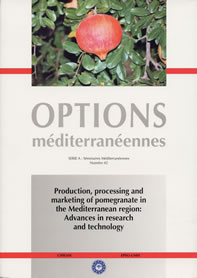| Article précédent | p. 123-127 | Article suivant |
Evolution of pomegranate juice anthocyanins during the ripening of fruit of three clones: ME16, VA1 and BA1
Six anthocyanin pigments were found to be responsible for the red colour of pomegranate juice (cv 'Mollar de Elche', 'Valencia' and 'Borde de Albatera'). These were analysed quantitatively and qualitatively using HPLC and identified as delphinidin 3-glucoside and 3,5-diglucoside, cyanidin 3-glucoside and 3,5-diglucoside, and pelargonidin 3-glucoside and 3,5-diglucoside. Generally, there is an increase in juice pigmentation with fruit ripening. In the early fruit development stages, delphinidin 3,5-diglucoside was the main pigment, followed by cyanidin 3,5-diglucoside, while in the late stages of fruit development, the 3-glucoside of cyanidin and delphinidin increased considerably. The pelargonidin derivatives are always present in much smaller amounts, and were even difficult to quantify in some instances.
- [ Afficher ]
- [ Télécharger ]
- [ Exporter la citation ]
Vous pouvez télécharger la citation au format :
- [ Imprimer ]
-
Mots-clés
ANTHOCYANE, CLONE, GRENADE FRUITS, MURISSAGE, PIGMENTCiter cet article
Melgarejo P., Hernández F., Martínez J. Evolution of pomegranate juice anthocyanins during the ripening of fruit of three clones: ME16, VA1 and BA1. In : Melgarejo P. (ed.), Martínez-Nicolás J.J. (ed.), Martínez-Tomé J. (ed.). Production, processing and marketing of pomegranate in the Mediterranean region: Advances in research and technology. Zaragoza : CIHEAM, 2000. p. 123-127. (Options Méditerranéennes : Série A. Séminaires Méditerranéens; n. 42). Symposium on 'Production, processing and marketing of pomegranate in the Mediterranean region: Advances in research and technology', 1998/10/15-17, Orihuela (Spain). http://om.ciheam.org/om/pdf/a42/00600261.pdf



